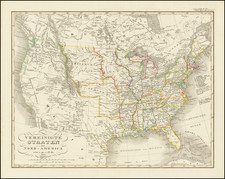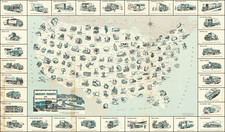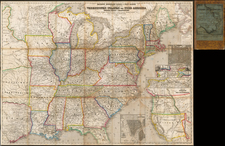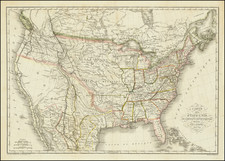Fine example of this scarce map of the Gulf Stream, prepared by A.D. Bache as the Superintendant of the United States Coast Survey, but privately printed by Edmund Blunt in New York.
The map is one of the most accurate and detailed surveys of the Gulf Coast to date, compiled under the direction of Bache, whose family members, Benjamin Franklin and Timothy Folger, were instrumental in the original discovery and dissemination of information and maps describing the Gulf Stream.
Alexander Dallas Bache was an American physicist, scientist and surveyor (and great-grandson of Benjamin Franklin), who erected coastal fortifications and conducted a detailed survey mapping of the United States coastline.
The strength of the flow of the current was first observed by Juan Ponce de Leon on his return trip from St. Augustine, Florida in 1513. His pilot, Anton de Alaminos, utilized his observations to chart a course for Cortes' treasure ships returning from Mexico which significantly shortened the transatlantic voyage home. While the Spanish sailed the Gulf Stream waters for centuries, they managed to keep the existence of the Gulf Stream a secret from other nations.
The western portion of the "Northeast Current," as it was known before Franklin named it the Gulf Stream in 1762, was first described by Walter Haxton, a captain engaged in shipping tobacco from his Maryland farms to London merchants. In 1735 Haxton drew the first large-scale mariner's chart of Chesapeake Bay, giving detailed soundings and sailing directions. He included, as an addendum to the chart, latitude and longitude points locating the "Northeast Current" along with estimates of the current's velocity. While Haxton advocated use of the current for future crossings, he was largely ignored.
Benjamin Franklin began his study of the Gulf Stream in 1768, while serving as the postmaster of the British Colonies in North America. Franklin had observed that the westward crossings were taking 2 weeks longer than the return journey and observed that this was a result of the current. Franklin discussed the matter with his cousin Timothy Folger, a Nantucket Sea Captain who had worked his way up the ranks on New England fishing and merchant ships, who informed him of the current and his experiences. Franklin in turn asked Folger to compose a chart showing the location of the Gulf Stream.
Franklin transmitted the finished chart to the British Postal Service and suggested that it be published for use by British Sea Captains charged with transmitting mail across the Atlantic. Instead of publishing a new map, the Post Office utilized an old chart of the Atlantic published by Mount & Page and had Folger's information engraved on what amounted to an obsolete chart in 1768. The charts were distributed to Packet Captains for a brief period of time, but were largely ignored.
In 1775 and 1776, Franklin made two Atlantic crossings, during which time he tested the water temperatures in and out of the Gulf Stream and determined that the waters in the stream were warmer. This revived his interest in the Folger chart. On his arrival in Paris, he had it copied and printed by Le Rouge. Franklin intended to provide copies to all French ship captains carrying arms and supplies to the American colonies.
In 1786, after the Revolutionary War, Benjamin Franklin published Folger's sketch of the Gulf Stream as part of an article in the Proceedings of the American Philosophical Society of Philadelphia. In the article, Franklin wrote: The Nantucket whalemen, being extremely well acquainted with the Gulf Stream, its course, strength and extent, by their constant practice of whaling on the edges of it, from their Island quite down to the Bahamas, this draft of that stream was obtained from one of them, Captain Folger, and caused to be engraved on the old chart in London for the benefit of navigators by B. Franklin.









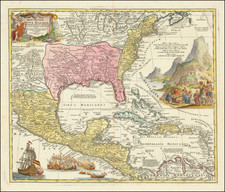
![[ United States ] Etats-Unis de l'Amerique](https://storage.googleapis.com/raremaps/img/small/98821.jpg)
